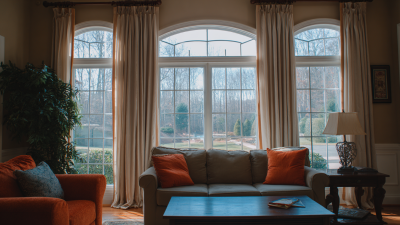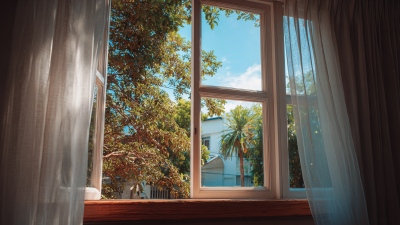5 Essential Tips for Using a Window Replacement Cost Estimator Effectively
When considering a home improvement project like window replacement, understanding the associated costs can be daunting. Utilizing a window replacement cost estimator effectively can significantly streamline this process and help homeowners make informed financial decisions. This tool not only provides a preliminary estimate of expenses but also empowers you to explore various options tailored to your specific needs. However, to maximize its benefits, it is crucial to approach the estimator with the right mindset and preparation. In this article, we will discuss five essential tips to enhance your experience with a window replacement cost estimator, ensuring you obtain accurate insights and avoid common pitfalls. Whether you're planning a budget or simply curious about the potential investment, these strategies will help you navigate the complexities of window replacement costs with confidence.

Understanding the Average Cost Range of Window Replacements in Your Region
When considering window replacements, understanding the average cost range in your region is crucial. This knowledge enables homeowners to budget effectively and make informed decisions. Generally, window replacement costs can vary significantly based on the type of window, materials used, and installation complexity. Regions with high demand or increased trade costs, as highlighted in recent reports, may see elevated pricing that reflects local economic conditions.

For those living in areas experiencing market fluctuations, like the recent housing instability in the UK, it becomes even more essential to use a window replacement cost estimator effectively. Adjusting expectations according to local averages can help identify the best options and manage expenses accordingly. Homeowners should prioritize obtaining multiple estimates, as this can reveal a range of costs that may deviate from expectations due to regional differences, ultimately allowing for better decision-making in this essential home improvement.
Key Features to Consider for Accurate Window Cost Estimates
When using a window replacement cost estimator, understanding its key features is crucial for obtaining accurate estimates. One primary factor to consider is the types of windows available. According to the National Association of Home Builders, the average cost for vinyl windows ranges from $300 to $700 per window, while fiberglass windows can go from $750 to $1,000 or more. A comprehensive estimator should allow users to input specific materials, influencing both price and insulation values.
Another essential feature is the geographical location input. The U.S. Census Bureau reports that window replacement costs can vary significantly by region, with homeowners in urban centers facing prices nearly 20% higher than those in rural areas. An effective estimator will reflect these variations, ensuring clients can make informed decisions based on local market trends. Additionally, the estimator should offer customization options, including sizes and styles, which can also impact the overall cost. By focusing on these features, homeowners can achieve more precise pricing estimates when planning their window replacement projects.
Utilizing Home Value Calculators to Gauge Window Replacement ROI
When considering window replacement, utilizing a home value calculator can significantly enhance your understanding of its return on investment (ROI). According to the Home Value Estimator, window replacement can yield an impressive ROI of up to 70%, making it one of the most fruitful home renovation projects. This high return illustrates the importance of energy-efficient windows as a means not just to enhance your home’s aesthetic appeal, but also to increase its market value.
In the recent Zonda Cost vs. Value Report, which highlights the financial benefits of various home improvements, upgrading windows continues to rank favorably among realtors and homeowners alike. Notably, the report identifies exterior renovations like new windows as vital for boosting curb appeal, which directly correlates with a significant increase in property value. As homeowners prepare for the housing market in 2025, investing in modern windows not only improves energy efficiency but is also a savvy financial move that translates into higher selling prices and a better overall return on your investment.
5 Essential Tips for Using a Window Replacement Cost Estimator Effectively
| Tip | Description | Estimated Cost Range | Potential ROI |
|---|---|---|---|
| Research Window Types | Understand different window styles and energy efficiencies available. | $300 - $1,200 each | 70% - 85% |
| Consider Installation Costs | Get estimates for installation to include in your overall cost assessment. | $100 - $300 per window | Varies by complexity |
| Use Online Calculators | Leverage home value calculators to assess your potential return on investment (ROI). | N/A | 100%+ in energy savings over time |
| Check Local Regulations | Research local codes and permits required for window replacement. | $50 - $250 for permits | N/A |
| Get Multiple Quotes | Obtain quotes from several contractors to compare prices and offerings. | N/A | Potentially lower costs |
Adjusting Estimates Based on Window Types and Energy Efficiency Ratings
 When using a window replacement cost estimator, it's crucial to consider the various types of windows and their corresponding energy efficiency ratings. Different window styles, such as double-hung, casement, and sliding windows, come with distinct pricing structures influenced by their material, design complexity, and installation costs. For instance, energy-efficient windows often incorporate advanced technologies like low-emissivity (low-E) coatings and argon gas fills, which might increase the initial investment but can lead to substantial savings in energy bills over time. As such, it's essential to assess not just the upfront costs but also the long-term return on investment based on the window types selected.
When using a window replacement cost estimator, it's crucial to consider the various types of windows and their corresponding energy efficiency ratings. Different window styles, such as double-hung, casement, and sliding windows, come with distinct pricing structures influenced by their material, design complexity, and installation costs. For instance, energy-efficient windows often incorporate advanced technologies like low-emissivity (low-E) coatings and argon gas fills, which might increase the initial investment but can lead to substantial savings in energy bills over time. As such, it's essential to assess not just the upfront costs but also the long-term return on investment based on the window types selected.
Moreover, the energy efficiency rating plays a pivotal role in determining the overall expenditure. Windows with higher energy efficiency ratings, such as those certified by Energy Star, typically offer better insulation and lower U-values, which can significantly reduce heating and cooling costs. When using an estimator, it's beneficial to input different window types and their efficiency ratings to understand how these factors impact the total projected expenses. By adjusting your estimates based on these parameters, you can make a more informed decision that balances aesthetic appeal, functionality, and cost-effectiveness for your window replacement project.
Leveraging Local Contractor Reviews for Trustworthy Cost Estimates
When seeking reliable cost estimates for window replacement, leveraging local contractor reviews is essential. These reviews not only reflect the quality of work delivered by contractors but also highlight their reputation within the community. A good understanding of the experiences shared by previous customers can provide insights into the typical cost ranges, allowing homeowners to make informed decisions. It's crucial to focus on patterns in reviews, such as consistently high ratings or frequent mentions of specific services, which can indicate reliable pricing and quality workmanship.
Moreover, integrating modern technology like machine learning in evaluating contractor data can enhance this process further. By analyzing trends in contractor performance and customer feedback, homeowners can better predict costs and avoid potential pitfalls. Engaging with local community forums can also yield unfiltered opinions, helping to build a trustworthy picture of what to expect. In this digital age, understanding that a reputable local contractor often results in more accurate estimates and higher customer satisfaction can significantly impact your window replacement journey.
Related Posts
-

Unlocking Potential: The Ultimate Guide to Retrofit Windows for Energy Efficiency and Modern Living
-

What is the True Cost of Window Replacement? A Detailed Breakdown with Industry Insights
-

5 Essential Tips for Choosing the Right Window Replacements for Your Home
-

How to Accurately Calculate Your Window Estimate for Home Renovation Projects
-

Ultimate Guide to Choosing the Right Windows for Your Home Make the Best Decision
-

7 Essential Features to Look for in the Best Residential Windows
